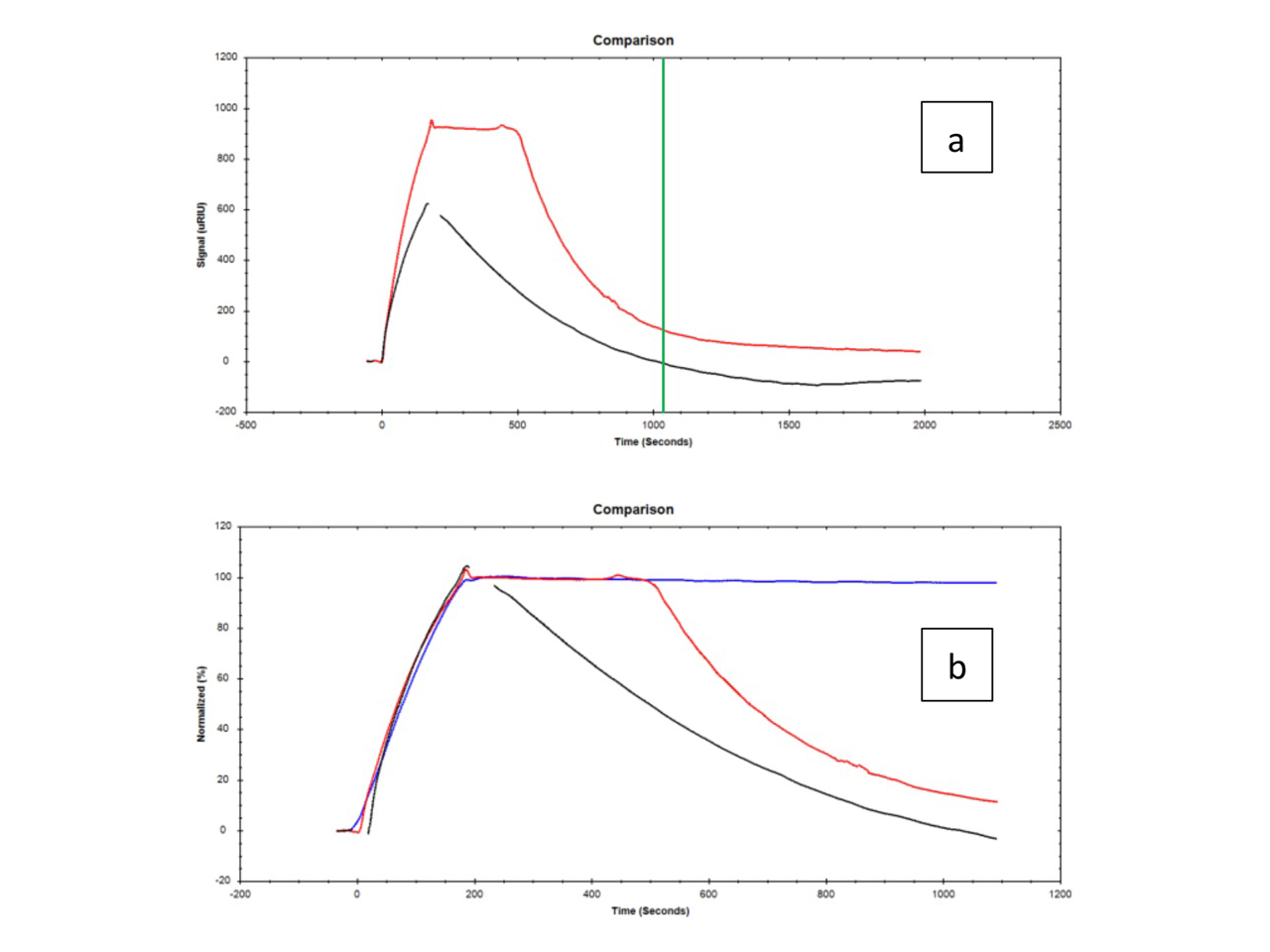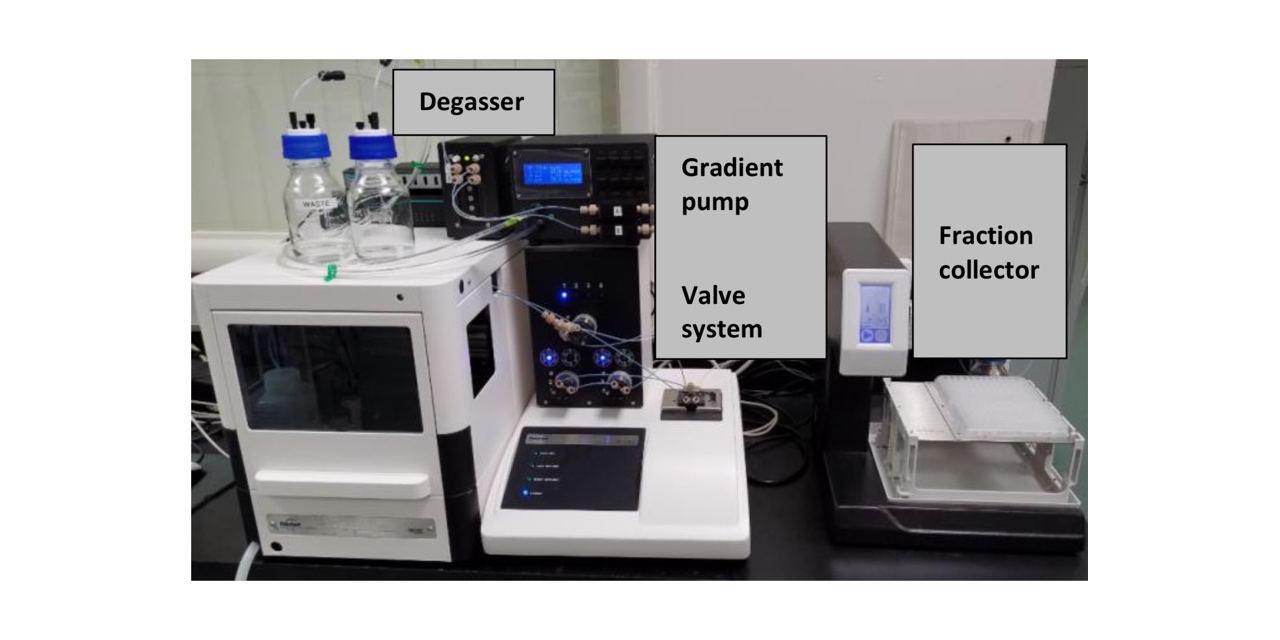Surface Plasmon Resonance (SPR) analysis has traditionally been carried out using a single (isocratic) buffer to monitor biomolecular interactions (association and dissociation of biomolecules). In contrast, chromatographers have been able to analyze samples using either an isocratic buffer or by doing a gradient separation (where one can program changes in buffer composition over the course of an analysis) for many years. Reichert has extended the range of SPR analysis to also include gradient analysis. In the case presented here, a linear pH gradient is applied to follow the dissociation of an antibody (analyte) from an immobilized antigen (target). Carrying out a gradient dissociation extends the range of information gained from each SPR injection. The pulse free gradient pump (with degasser) employed in this application can be used to more efficiently and quickly determine analyte behavior when buffer pH, salt content, detergent, and/or solvent content is changed over the course of the analyte‘s dissociation.
In a standard SPR experiment with an isocratic pump, the injection of an analyte over a target produces a specific association curve. When the injection ends, the dissociation is followed for a specific period of time and results in either a return to baseline, or, if the dissociation is slower and remaining analyte needs to be removed, with a regeneration solution being injected prior to the next analyte injection. Initially, there are typically a number of trial and error injections needed to determine the proper regeneration solution.
To gain more information from a single experiment, the Reichert gradient pump was developed in coordination with a Reichert SPR-Plus system. This gradient pump allows the makeup of the running buffer to be varied linearly over the course of analyte dissociation. For instance, in the current experiment, varying pH results in complete dissociation of an analyte that is a very strong binder in standard buffer alone at a physiological pH of 7.4. Varying pH over the course of analyte dissociation can allow one to determine the optimum pH for regeneration, using only one injection, for a particular dissociation of analyte from target. The pneumatic pump employed for this application uses compressed air to create force to push fluid through the tubing, making the flow pulse-free, so no refills need to be programmed.
Experimental
Background
Anti-BSA binding to immobilized BSA is used as a model assay.
Conditions
- Instrument: SR7500DC/Reichert2SPR
- Sensor Chips: Planar
- Temperature: 25°C
- Target: Bovine Serum Albumin (BSA), 1023 mRIU immobilized
- Analyte: Anti-Bovine Serum Albumin (Anti-BSA), Conc. 4 nM
- Buffer A: PBST or Water
- Buffer B: 20 mM hydrochloric acid (HCl)
- Association: 3 minutes, 45 mL/min Buffer A, 5 mL/min Buffer B
- Normal Dissociation: Buffer A same flow rates as association
- Dissociation: linear gradient program: 45 mL/min Buffer A to 5 mL/min Buffer A over 30 minutes 5 mL/min Buffer B to 45 mL/min Buffer B over 30 minutes
Results
The sensorgrams obtained from Anti-BSA injections using a standard isocratic association followed by a gradient dissociation using either PBST (red curve) or Water (black curve) for Buffer A are shown in Figure 1a. For approximately the first 5 minutes of the gradient dissociation using PBST buffer (red curve), no change in response is seen (it follows an isocratic dissociation like the blue curve in Figure 1b) as the buffer capacity has not yet been reached. When only water is used as Buffer A (black curve), the effect of changing pH is immediate and results in complete dissociation about halfway into the dissociation (indicated by green line in Figure 1a corresponding to approximately 10 mM HCl). Figure 1b shows the first two Anti-BSA sensorgrams with gradient dissociations (from Figure 1a) overlaid with a sensorgram with a typical isocratic dissociation (blue curve) where the rate of dissociation is very slow. Curves are normalized in Figure 1b.

a) Anti-BSA injections: isocratic associations, gradient dissociations (red Buffer/20mM HCl, black Water/20mM HCl). Green line is where dissociation is complete for water/20mM HCl gradient mixture.
b) Anti-BSA isocratic association curves followed by either isocratic dissociation (blue curve) or gradient dissociations (red and black curves from Figure 1a).
Summary
Addition of a gradient pump to an SPR setup provides added flexibility and utility. Use of a pulse-free pneumatic pump such as we employ here eliminates the effects of pump refills and provides accurate flow over a range of typical SPR flow rates. A user can vary such parameters as buffer pH, salt content, detergent, and/or solvent content and see how they affect analyte dissociation. The ability to vary running buffer composition over the course of a dissociation can allow one to remove tight binders more gently than with when using traditional regeneration conditions and could allow users to selectively dissociate one compound only in a mixture where both bound to the same target.
The full SPR-Plus system (Figure 2) has an additional valve system which can facilitate the use of an in-line separation column. It also includes a fraction collector, which enables the user to collect fractions which can then be taken to another detector (eg. a mass spectrometer) to identify what has been eluted.
